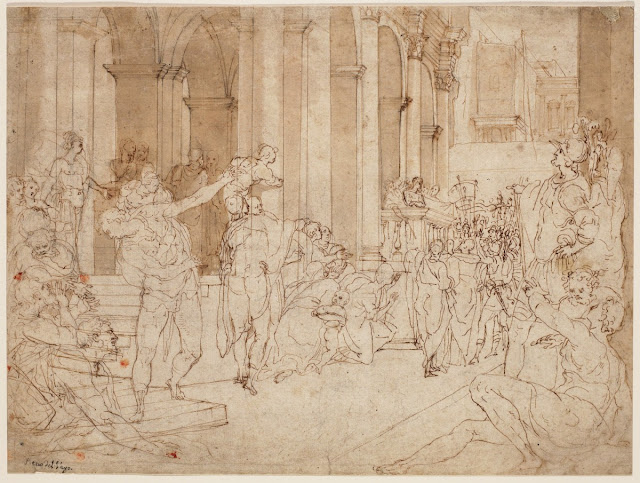 |
| Marcello Venusti after Michelangelo Reclining Figure, severely foreshortened before 1579 drawing Rijksmuseum, Amsterdam |
 |
| Joseph Heintz the Elder Sacrifice of Isaac ca. 1580-85 drawing National Gallery of Canada, Ottawa |
 |
| Joseph Heintz the Elder Venus, Anteros and a Satyr ca. 1601 drawing National Gallery of Canada, Ottawa |
"Before the entrance to the Academy is an altar to Love, with an inscription that Charmus was the first Athenian to dedicate an altar to that god. The altar within the city called the altar of Anteros (Love Avenged) they say was dedicated by resident aliens, because the Athenian Meles, spurning the love of Timagoras, a resident alien, bade him ascend to the highest point of the rock and cast himself down. Now Timagoras took no account of his life, and was ready to gratify the youth in any of his requests, so he went and cast himself down. When Meles saw that Timagoras was dead, he suffered such pangs of remorse that he threw himself from the same rock and so died. From this time the resident aliens worshipped as Anteros the avenging spirit of Timagoras."
– Pausanias, from Description of Greece (ca. AD 150-175), translated by W.H.S. Jones (1918)
"But the other account proclaims that Poseidon was the lover of Nerites, and that Nerites returned his love, and that this was the origin of the celebrated Anteros (Mutual Love). And so, as I am told, for the rest the favourite spent his time with his lover, and moreover when Poseidon drove his chariot over the waves, all other great fishes as well as dolphins and tritons too, sprang up from their deep haunts and gambolled and danced around the chariot, only to be left utterly and far behind by the speed of his horses; only the boy favourite was his escort close at hand, and before them the waves sank to rest and the sea parted out of reverence to Poseidon, for the god willed that his beautiful favourite should not only be highly esteemed for other reasons but should also be pre-eminent at swimming."
– Aelian, from On Animals (ca. AD 165-170), translated by A.F. Scholfield (1958)
"Love if he be not twin-born, yet hath a brother wondrous like him, called Anteros: whom while he seeks all about, his chance is to meet with many false and faining Desires, that wander singly up and down in his likeness. By them in their borrowed garb, Love, though not wholly blind, as poets wrong him, yet having but one eye, as being born an Archer aiming, and that eye is not the quickest in this dark region here below, which is not Love's proper sphere, partly out of the simplicity and credulity which is native to him, often deceived, embraces and consorts him with these obvious and suborned striplings, as if they were his Mother's own Sons, for so he thinks them, while they subtley keep themselves most on his blind side. But after a while, as his manner is, when soaring up into the high Tower of his Apogaeum, above the shadow of the earth, he darts out the direct rays of his then most piercing eyesight upon the impostures and trim disguises that were used with him, and discerns that this is not his genuine brother, as he imagined, he has no longer that power to hold fellowship with such a personated mate. For straight his arrows lose their golden heads and shed their purple feathers, his silken braids untwine and slip their knots, and that original and fiery virtue, given him by Fate, all on a sudden goes out and leaves him undeified and despoiled of all his force: till finding Anteros at last, he kindles and repairs the almost faded ammunition of his Deity by the reflection of a coequal and homogenial fire."
– John Milton, from The Doctrine and Discipline of Divorce (1643-44)
 |
| Girolamo Macchietti St John the Baptist with Lamb ca. 1575-76 drawing Metropolitan Museum of Art, New York |
 |
| Cherubino Alberti Putti supporting blank rectangular banner before 1615 drawing Rijksmuseum, Amsterdam |
 |
| Giovanni Alberti Striding Putto ca. 1596-1600 drawing National Gallery of Canada, Ottawa |
 |
| Anonymous Italian artist Architectural sketches and Female Figure 16th century drawing Metropolitan Museum of Art, New York |
 |
| Anonymous Italian artist working in Rome Drapery Study ca. 1560-70 drawing Minneapolis Institute of Art |
 |
| Stradanus Hunting Scene ca. 1580-96 drawing National Gallery of Canada, Ottawa |
 |
| Hendrik Goltzius Farnese Flora (Naples) 1590-91 drawing Teylers Museum, Haarlem |
 |
| Orazio Sammachini Standing Putto ca. 1550 drawing National Gallery of Canada, Ottawa |
 |
| Francesco Salviati Head of an Ecclesiastic before 1563 drawing National Gallery of Canada, Ottawa |
 |
| Taddeo Zuccaro Christ shown to the People ca. 1553-56 drawing National Gallery of Canada, Ottawa |
 |
| Federico Zuccaro Woman gesturing before 1609 drawing Agnes Etherington Art Centre, Queen's University, Kingston, Ontario |